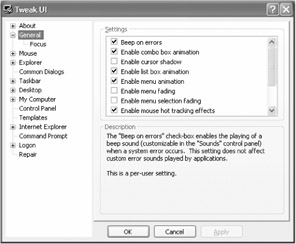General
|
|
The items in the Settings list in the General category are effects that you can enable or disable. In fact, the Settings list, shown in Figure 5-1, used to be called the Effects list in earlier versions of Tweak UI. Settings range from list box and window animations to menu fading. Disable these settings only on slower computers when you think you can improve the user interface's crispness; otherwise, these settings make Windows XP look great.

Figure 5-1: Many of these settings are in the Performance Options dialog box. Right-click My Computer, click Properties, and in the Performance area of the Advanced tab of the Properties dialog box, click Settings.
You see all the settings in the General category in Table 5-1. One value needs a bit of explaining, though: UserPreferencesMask. The bits in this REG_BINARY value are various settings, which Chapter 4, "Hacking the Registry," and Appendix B, "Per-User Settings," describe in detail. To turn on a setting, set the appropriate bit to 1 in UserPreferencesMask. To turn off a setting, clear the corresponding bit. The number in the Data column tells you which bit to toggle. The easiest way to toggle the bit is to use Calculator in scientific mode. Bitwise math is beyond most simple scripting techniques, including REG files. If you want to create a script to change the settings in UserPreferencesMask, use INF files or look to Windows Scripting Host (see Chapter 9, "Scripting Registry Changes").
| Setting | Name | Type | Data |
|---|---|---|---|
| HKCU\Control Panel\Sound | |||
| Beep on errors | Beep | REG_SZ | Yes | No |
| HKCU\Control Panel\Desktop | |||
| Enable combo box animation | UserPreferencesMask | REG_BINARY | Bit 0x0004 |
| Enable cursor shadow | UserPreferencesMask | REG_BINARY | Bit 0x2000 |
| Enable list box animation | UserPreferencesMask | REG_BINARY | Bit 0x0008 |
| Enable menu animation | UserPreferencesMask | REG_BINARY | Bit 0x0002 |
| Enable menu fading | UserPreferencesMask | REG_BINARY | Bit 0x0200 |
| Enable menu selection fading | UserPreferencesMask | REG_BINARY | Bit 0x0400 |
| Enable mouse hot tracking effects | UserPreferencesMask | REG_BINARY | Bit 0x0080 |
| Enable tooltip animation | UserPreferencesMask | REG_BINARY | Bit 0x0800 |
| Enable tooltip fade | UserPreferencesMask | REG_BINARY | Bit 0x1000 |
| Show Windows version on desktop | PaintDesktopVersion | REG_DWORD | 0X00 | 0X01 |
| HKCU\Control Panel\Desktop\WindowMetrics | |||
| Enable Window Animation | MinAnimate | REG_SZ | 0 | 1 |
| Tip | UserPreferencesMask is an example of a REG_DWORD value disguised as a REG_BINARY value. When you see a 32-bit binary value, chances are, it's really a double-word value. In that case, you can safely replace the value with a REG_DWORD. Don't forget that Windows XP uses the little-endian architecture, though, so it stores double-word values in reverse-byte order. In other words, you replace the REG_BINARY value 0x04 0x03 0x02 0x01 with the REG_DWORD 0x01020304. See Chapter 1, "Learning the Basics," for a refresher on little-endian architecture and bitwise math. |
Are you curious about how I tracked down all the Tweak UI program's settings? I used the techniques you learn about in Chapter 8, "Finding Registry Settings." The first technique is a program from Winternals Software called Registry Monitor that monitors access to the registry. It reports every setting that Windows XP or other programs read or write.
The second technique, and the one that I used most, is to compare snapshots of the registry before and after making the change. Here's how that process worked for me while writing this chapter:
-
Export the branch of the registry that you suspect contains the setting to a REG file. If in doubt, export the entire registry. Name the file Before.reg.
-
Change the setting. In this case, change a setting in Tweak UI.
-
Export the same branch of the registry that you exported in step 1. Name the file After.reg.
-
Compare both files; the differences between them represent the changes in the registry.
The primary tool that I use to compare REG files is Windiff, which comes with the Windows XP Support Tools and the Windows 2000 Resource Kit. If you don't have Windiff, you can use Microsoft Word 2002 just as effectively: Open the first REG file in Word, and then click Tools, Compare And Merge Documents to compare it to the second file.
Focus
When an application needs your attention—or when it simply wants to annoy you—it steals the focus from the application in which you're currently working. This leads to frustration as you flip back and forth between windows. The settings in the Focus category prevent that scenario by causing applications to flash their taskbar buttons to get your attention rather than stealing focus from the application in the foreground.
Table 5-2 describes the settings in the Focus category. The default value for ForegroundLockTimeout is 0x00030D40, or 200000. This value is the time in milliseconds before Windows XP allows an application to steal the focus from the foreground application. To convert 200000 to seconds, divide it by 1000 (200 seconds). You see the value ForegroundFlashCount in the table twice, because setting it to 0 causes the taskbar button to flash until you click it; otherwise, the taskbar button flashes the number of times you set in ForegroundFlashCount.
| Setting | Name | Type | Data |
|---|---|---|---|
| HKCU\Control Panel\Desktop | |||
| Prevent applications from stealing focus | ForegroundLockTimeout | REG_DWORD | N |
| Flash taskbar button until I click on it | ForegroundFlashCount | REG_DWORD | 0x00 |
| Flash taskbar button N times | ForegroundFlashCount | REG_DWORD | N |
|
|
EAN: 2147483647
Pages: 185